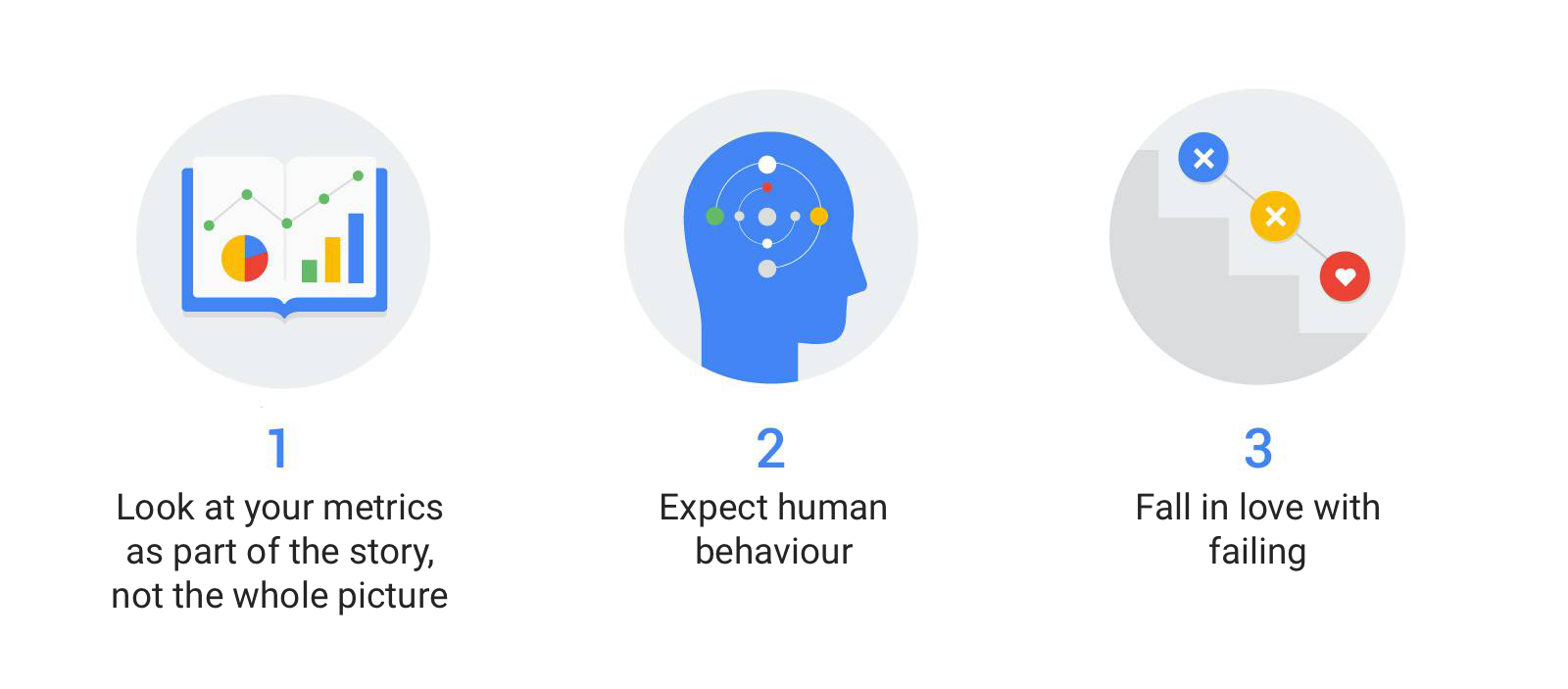As the global head of customer analytics at Google, Neil Hoyne has spent years studying the technical aspects of measurement and how to strengthen the analytical cultures at world-leading organisations. Here he shares what the top companies get right about measurement.
Time and again, I see companies making crushingly common mistakes with data, and refusing to give themselves the room to experiment and to fail.
Data empowers marketers to make better decisions and take smarter risks, but sometimes the best intentions lead to the wrong solutions. Interpreting data isn’t always easy, and I’ve seen marketers come up short by not allowing themselves the space to learn, grow, fail and improve from their collective experiences.
A campaign that falls short of its goal can teach just as much as one that succeeds. And marketers who wish to do the right thing well can learn from how they do the right thing poorly.
What I’ve noticed is that marketers have become experts at doing the wrong thing, because they’re grounded by the past and the “way we’ve always done it”. Their organisations expect them to succeed, even if that success is dependent on the wrong technique or marketing channel, or in pursuit of customers who are detrimental to the company’s long-term growth.
Top companies don’t just look at their metrics as numbers. They look at their metrics as opportunities to ask more questions.
But I’ve also seen what companies can do when they allow themselves to take steps in the right direction, even if they fall flat at first.
Here are a few examples of how successful data-first organisations think, and how you can apply them to your business.
Tips on how to be a successful data-first organisation

Look at your metrics as part of a story, not the whole picture
One of the biggest mistakes that a marketer can make is to look at their data in isolation. If you oversimplify your data, you’ll lose out on the magic that’s happening around you.
One thing that I’ve observed from successful companies is that they don’t capture metrics for the sake of it. For every metric that they set and optimise towards, they go a level deeper by asking themselves some key questions.
● Do I know what this metric truly means? Let’s look at conversions, for example. They are central to everyone’s business, but not all conversions are created equal. When considering cross-device users, online-to-offline users and view-through conversions, we start to see real differences emerge between platforms. And those differences could determine how you interpret performance measurement and future spend. It’s important to understand the specifics and the distinctions when calculating for each metric.
● What could influence this metric, and how? The late Andy Grove, former CEO of Intel, said: “For every metric, there should be another ‘paired’ metric that addresses the adverse consequences of the first.” I suggest taking his advice to heart. If you are optimising toward using deals or coupons that are driving a ton of customers to your store, are you doing so to the detriment of profit margins and customer retention?
● Am I limiting what I can learn from my metrics? Don’t focus your attention solely on what’s underperforming. Think about what you can learn from what you’re doing well, but could do even better. If you’re a shoe company and you’ve successfully incentivised people to buy multiple pairs of your shoes online, that’s a great win. But why did that happen? Do you even know? Can you replicate the findings to other marketing activities?
I’ve seen that successful companies don’t just look at their metrics as numbers. They look at their metrics as opportunities to ask more questions: Where is the market headed? What should we be aware of? That way, a single metric becomes part of a larger story, not the whole picture.
Expect human behaviour
Machine learning is growing fast and teaching us a lot. But people are not machines, and as such, they’re not always rational, efficient bidding and buying engines. They don’t necessarily respond in the way that you’d think they might. As a marketer, you have to plan for that by gaining a better understanding of the human story behind your data — because it’s those behaviours that may drive your business forward.
Here are some examples of what I mean from recent research on behavioural economics.
● Slow doesn’t always mean no. It’s hard to deny that, when it comes to site speed, faster is far better. The longer people wait for your site to load, the more you’ll lose. But a study by Harvard Business School found that, due to what it called the “operational transparency”, people can tolerate — and, in some cases, prefer — websites with longer waits as long as there is an understanding of the work being performed. If you demonstrate that your site is exerting effort on a customer’s behalf (consider Domino’s Pizza tracker, which keeps you updated every step of the way in the journey to getting your pizza), it can contribute to having a stronger sense of loyalty and reciprocity toward your company.
In some cases, lowering prices can actually lead to customer churn.

● The perils of proactivity. Facing the challenge of increased customer attrition, many service companies will start to recommend lower-cost pricing plans to their customers in an effort to demonstrate care for their customers and the greater benefits that they can provide. Researchers from Columbia, Wharton and IAE Business Schools found this tactic had the opposite effect: Encouraging customers to switch to cost-minimising plans can actually increase churn. In some cases, it inspires customers to be less inert about making a change, and they start to look at other service providers.
I’m not suggesting you throw your conventional wisdom out the window with these varied examples of counterintuitive consumer behavior. But I think it’s important to know that successful companies know that you can’t predict every single element of the customer journey. No matter how much you measure, you’re not going to capture everything. If there are no perfect humans, there’s no perfect data.
Fall in love with failing
When we work with smaller businesses or startups, we tend to see some incredibly miserable attempts at marketing. That’s all part of growing, right? But we can learn so much from how these companies tend to respond to those failures: They look inward. They consider that perhaps their brand isn’t strong enough yet, or that they haven’t properly optimised their campaigns in these early stages. What they don’t do is look for something or somewhere else to place blame.
There are multiple components to performance measurement, and failure is one of them.
Here’s what I see over and over in larger organisations: They’ll test something, and if it fails, they’ll pivot immediately to a strategy with which they can win, arguing that the customers simply aren’t there or that the channel doesn’t work for their business.
This is where doing the right thing poorly needs to become your new manifesto, no matter what size your organisation is. There are multiple components to performance measurement, and failure is one of them.
Give yourself and your teams the ability to fail, with the understanding that it’s the first step to growth. And that growth can only come if you’re using your failures — and your successes — to ask questions, the key one being: What is the right thing for me to be doing?
Even if you can’t immediately take action on the answer, acknowledging it to yourself is the first step to doing the right thing well.







